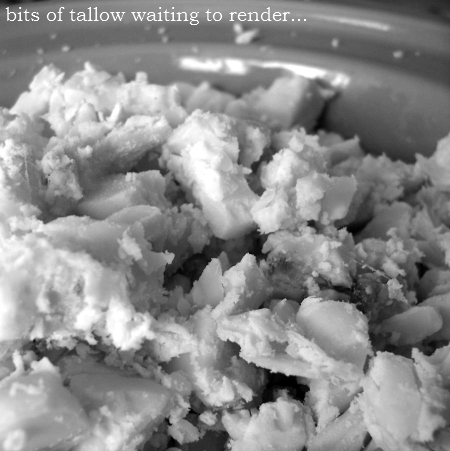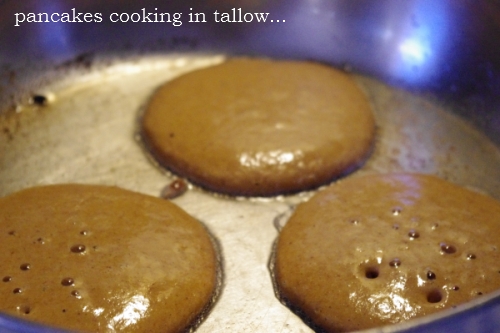How to Render Tallow or Lard (and how the science is in favor of animal fats)

This post was originally published in February of 2011… but our love for tallow and lard beats on.
One of the most important changes to our family’s diet over the past few years has been to only use stable fats for cooking. Before this I used olive or canola oil to cook just about everything and because I was told it was healthy I never questioned the slightly rancid taste that is the result of heating an unsaturated fat.
Now I only cook with tallow, lard, coconut oil, and occasionally butter. I use olive oil for salad dressings, but I am developing more cultured dairy based salad dressings since it seems more likely that we will have our own milk before we have our own olive trees.
The Science is in Favor of Saturated Fats
What is most disturbing to me about the smear campaign that lard and saturated fats have gotten is that people don’t even question it. If anyone truly wanted to know the science behind which fats are healthy they might have found out that very basic chemistry teaches that saturation = stability = less inflamation and free radicals in the body. And that it is ignorant to say that simply because a fat is solid at room temperature it will clog your arteries.
Or perhaps they would tell you that both lard and tallow contain only 1/3-2/3 saturated fat, the rest being mostly monounsaturated. (source) But don’t bore them with the details, they’ve got subsidized crops to push and no one makes money when you butcher an animal and render your own fat.
So yes, lard and beef tallow are healthier cooking fats than vegetable oils, including olive oil. They were the main cooking fats used in this country BEFORE the onset of the now epidemic diabetes, heart disease, and cancer. But the USDA recommendations are more about pushing policy than they are about true science.

How to Render Tallow or Lard
There are many ways to do this, all involving a slow and low-heat cooking process. You can do it on a stove top, in the oven, or in a slow-cooker. This is how I do it:
- Cut tallow (suet) or lard into small pieces, about 1/2 inch each. This increases the surface area so that it will melt more readily.
- Place in a large pot (for the stove top), a large pan (for the oven) or your slow-cooker insert. Some people also add a tiny bit of water, though I never have.
- Place your pot over very low heat, your pan in a low oven (250 degrees or so) or turn your slow-cooker to high until it begins to melt in earnest and then turn it down to low.
- Cook down until a clear liquid fat has been rendered from the small pieces of fat. I don’t know that there is an exact science to this, your goal is to get as much liquid fat out of those solid pieces as possible, without burning the fat. So this takes me 6-8 hours in a slow-cooker or a few hours in the oven or stovetop.
- While fat is still warm strain it into quart jars, being sure to strain off all solid pieces. Straining off the solid pieces will help keep the fat from spoiling for a much longer period of time.
- I currently store mine in the refrigerator, though I am researching a few of the ways it was stored before refrigeration. It should keep for months in the refrigerator.
How Others Do It
- The Healthy Home Economist :: A Video on Rendering Lard
- Cheeseslave :: How to Render Tallow & Lard
- Sifford Sojournal :: How Susan Renders Lard (& uses it for fat lamps!)
Have you tried rendering lard or tallow?



when I roast beef marrow and joint bones for stock, the tallow renders itself, more or less. I just strain it off as you say and store it in a Mason jar in the fridge. Delicious on green beans!
Thanks for this informative post!
You are amazing. We are just trying to see if we can afford a 1/2 side of grass fed beef this year (hubby doesn’t like pork, pastured chicken is more expensive per pound than beef, and I still need to try lamb before I get a whole one). I was thinking about rendering the suet/fat to make tallow. All of the blogs that I have seen only talk about lard (pork). Do you know if the tallow is as versatile as lard? I would want to use it for things like pie crust, biscuits, and other baked goods. The goal would be to replace butter so that most of our butter consumption is for toppings (like on bread/pancakes…) then maybe the butter from our raw grass fed milk would be enough for our needs (because sometimes you just NEED to slather butter on things).
Thanks! – Any news about a Simple Food {for spring} book?… 🙂
Waggie – From my (very limited) experience tallow and lard are a bit different in flavor, but similar. Both definitely have that animal fat flavor, but I think that’s what makes them so delicious. Tallow definitely has a “beefy” smell/flavor to it and lard definitely a “porky” flavor/smell to it. I like a half lard or tallow/half butter pie crust, and I am thinking biscuits with tallow would be so good. I do believe that our great grandmothers would have used lard and tallow for just about all cooking and baking unless they had a good amount of butter.
Great post. I tried to render lard once in my slow cooker and it turned into a burned nasty mess. I want to try again, but I have to get over my memory of the stench.
Thank you Thank you for posting this!! I have been wanting to start changing some of the fats we use. My son has ultra-high antibodies to coconut (among other things) so I have been using butter and olive oil for everything, butter is tasty, but occasionally we want to have butternut squash chips and I just use canola oil and cringe because I know it’s not the best.
I rendered a big batch of tallow from my 1/4 side of local pastured beef, and have been enjoying the results ever since. I chose to render it outside using a turkey deep fryer (propane burner), which seemed like a good idea given the lingering scent of beefiness in the vicinity. The tallow does have a noticeable savory flavor that I attributed to not trimming the fat chunks of meat or other tissues, but luckily the flavor goes well with lots of foods. I use it almost every day to cook my eggs in, and for most stir-fries and soups. I don’t eat much grain these days, but I did use it to make pastry crust (70% tallow, 30% butter), and the crust was extraordinary over turkey pot pie. So I’d think it would go well in any savory baked good.
you had me at pancakes cooking in tallow.
I am almost 68 now, but I remember when I was a child my mother used nothing but lard for her best baking. She made pie crust that would melt in your mouth. I helped mix the cookie dough when we had to blend the sugar into the lard. I haven’t had a good pie since Mom died and now I know I am a celiac and cannot even try anymore pie. I am glad I have that wonderful memory in my mind. I remember the plum pie and my mouth waters. Mom also kept all the bacon drippings in an empty tin can on the back of the stove and that is what she used to oil pans or add flavoring to veggies. None of us had any of the health problems young people have today. My father is 97 and still going strong. Mom had other health issues that took her life at 69, and I wish every day that she was here and still teaching me all the stuff she learned in her life. She would tell all of us to never eat anything out of a box; little out of cans and plant a garden. Smart lady from a smart generation.
Thank you for the post! I’m so thankful to have access to your knowledge and experiences with food. You’re mentoring a whole new generation here! I have lots of questions, if you don’t mind… 🙂
This process starts with uncooked fat, right?
It is ever possible to save and use the accumulated beef/pork fat that’s left in the pan after cooking a meal? Would it is also have to be reheated and strained, or just strained?
What is your opinion on using bacon fat and sausage fat for cooking? Do they requiring a rendering process as well, or can you just pour the leftover hot fat into a mason jar, kept in the fridge, and spoon it out when needed?
Is it not worth using animal fat if it has not come from pastured/grass-fed animals?
Do you have resources you recommend for purchasing quality tallow and suet?
Oh MY! YES!! I render tallow on a regular basis. Though I have been banned from the garage for this by my dear husband and am relegated to the shed. It does have electricity and I have been using an 18 quart roasting oven and a crock pot. Though in my crock pot it takes me days and that is on high! Maybe that is because my crock pot heats at a lower temp?? The roaster takes about 8 hours or so and I usually do this overnight. I did try using two roasting ovens at the same time once. I kept blowing the fuse/tripping the breaker. Sigh. The adventures in tallow rendering!
I haven’t used my tallow for eating though! I make homemade soap from my personally rendered tallow. I will have to try using it in cooking too! For the most part I have used coconut oil for all my sauteeing and frying.
Blessings,
~Mrs. R
Ooops, I forgot to ask you a few questions about your experience in cooking with the tallow and lard.
For the lard: My mom always made her pie crusts with lard. When I started making pies I did the same thing. Yes, they are very flakey, but I can not stand the lard-y taste. Gives me the shivers. What do you use lard for in your cooking?
On tallow in cooking: do you notice a taste from the tallow or is it tasteless? Have you used it in pie crusts? Right now I use palm shortening. No hydrogenated stuff for my family!!
Thanks for the post!!
Blessings,
~Mrs. R
Mrs. R – I have found that lard can have a strong meaty flavor or not, depending on how well the lard was rendered. In other words, if it is cooked over very low heat and not allowed to burn at all it isn’t nearly as meaty.
I use lard and tallow for frying just about anything – eggs, potatoes, vegetables, pancakes, doughnuts, etc. It is also an excellent replacement for butter or shortening in baked goods like pies, biscuits, cookies, and more. I don’t do a lot of baking anymore since we do not eat a lot of grains, but I believe that our foremothers used lard or tallow for what we now use shortening and butter for in baking.
Lard used to be the de facto oil used by hawkers in Asia until the vegetable oil propaganda took hold. Now trying to hunt down one stall that uses lard is so tough and when you do spot one, the hawker would pretend that it’s vegetable oil in fear of incurring any wrath from ‘health-conscious’ customers!
I am just learning about ‘real food’ and could really use a crash course on the very basics of working with tallow/lard in cooking! I would have to second all of Kaitlyn’s questions.. .Also can tallow/lard be used on a 1:1 ratio for olive oil/canola oil in recipes most of the time?
Rachel – I believe so. It is solid so you must melt it first, but I think that their saturated fat content makes them a suitable replacement for butter and shortening as well.
Where do you buy suet to render? When I made stock with meaty knuckle bones a lot of fat rose to the top as it cooled. I saved it and put it in refried beans I made the next day. They were the best tasting beans I’ve ever made! Would the fat that I used be considered tallow? I think I simmered the stock for 12 hours. Thanks!
FYI, I just rendered some tallow in my crock pot (aka slow cooker) ON LOW and 20 hours later it came out beautifully. I did trim the fat carefully beforehand. It’s very slightly golden at room temperature, which I understand is normal for grass-fed beef.
Wonderful post! This is a skill that not only saves money, but the results also have innumerable health benefits.
Do you strain the fat through filter paper or kitchen towels, or do you just use an ordinary sieve? I always seem to make such a mess during the stringing phase!
We use both lard and tallow and have rendered them ourselves. I find the lard easy to do, but was not sure about the tallow. It was hard to get past the smell. We have a side of beef coming in a few days so I’ll give tallow another try. Haven’t been able to find a pig to buy recently so ordered pre-made lard and tallow made from the fat of local pastured animals from our local food co-op. A large tub, almost 3 lbs, runs about $10.50, so is pretty reasonable as fats go around here. At some point, though, when we can raise our own hogs and beef, we hope to make all our own fats. Great topic!
Actually, I have a question about this. I know for lard you’re supposed to request the “leaf fat” from around the internal organs for the best lard. Is that the same with tallow? I need to call the butcher and ask for the fat and was wondering if there a certain area it’s best from? Thanks.
I do this once or twice a year. I cut up the tallow or lard into chunks, put it in a deep fryer (fry daddy etc) and turn it on 300-350 degrees. I let the fat liquefy and use the metal basket to strain out any chunks. Viola, done in 15 minutes!
I do this but then do a further step of clarifying (learnt from my grandmother) by putting it in a pot of col water and bringing it to the boil. Chill and you’ll have a big disk of fat on top – drain the water, wipe the bottom of your disk of tallow and refrigerate until use.
You want to add a little water to your lard pot – it helps with the rendering. I didn’t use a slow cooker – I just filled a stock pot with fat and 1/4 c of water, set on a low flame – it was an easy foolproof result.
@Carty – tallow is from beef and lard is from pork. Leaf fat is the supreme choice but I’ve been using regular fat with great results. It’s pure white and very mild/neutral flavored.
Great post. I tried to render lard once in my slow cooker and it turned into a burned nasty mess. I want to try again, but I have to get over my memory of the stench.